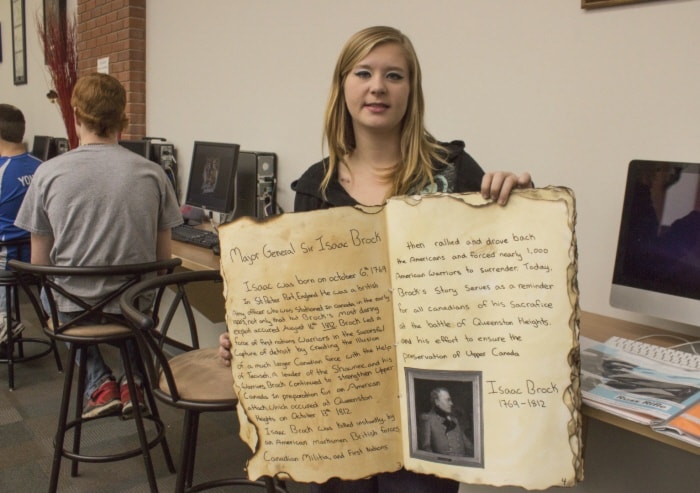Looking at Canada’s war efforts through history brought out a creative spark in Samantha Mielke’s Grade 11 social studies classes.
The students’ projects were on display at William E. Hay Composite High School on Tuesday, Nov. 4, where they were viewed by their peers and other guests, including members of the local Royal Canadian Legion branch.
Mielke explained that the students were given free rein to pursue any creative project as long as it fit under the theme of Canadian nationalism in times of war.
“There were really no parameters to this, other than ‘it must be creative,’” said Mielke, adding that the results went well beyond her expectations.
The students’ efforts used a variety of media, from posters, slideshows and prose to poems, dance and even a welding project.
Mielke said the students were “nervous” about the reception to their work, adding she believed that demonstrated the level of energy they’d put into their projects.
While many of the projects were centred on the two World Wars, some students reached back further into Canadian history, like Ashley Sharpe.
She put together a large book featuring figures from the War of 1812, from military leaders like Sir Isaac Brock and Lt.-Col. Charles de Salaberry, to First Nations leaders like Tecumseh, and women of significance such as Laura Secord and Mary Henry.
Sharpe used tea bags to stain the pages and also burnt the edges of the book, giving it an aged look.
Brianna Webb used her creative writing skills to craft letters between a mother living on a Canadian farm and her underage son fighting in the Second World War.
The characters Webb used were fictional, but based on her research and the experiences of actual people. She also wrote a journal to provide further context from the mother’s perspective.
Todd Starling welded a miniature model of the Stettler cenotaph, while Matayah Loyst, a dancer with eight years’ experience, developed an interpretive dance to express the emotions of a soldier serving overseas, set to the Ron Pope song “You’re the Reason I Come Home.”
The projects were met with a positive response from legion representatives, including Walter Treherne, who served as a naval seaman and radar operator in the North Atlantic in 1943.
“It was interesting to take a look and listen to what they were saying,” he said. “It’s surprising when you see the young people today put that much work into it.”
As a navy man, Treherne said he didn’t see many projects address that area of the military, but he pointed to one project in particular that did.
Mark Bengert used a program called Prezi to create a multimedia presentation that looked at the lives of four Canadian military men who served in the Second World War in various branches.
He selected four servicemen and examined their backgrounds, as well as where they served, explaining, “It’s amazing how their lives changed.”
Between Mielke’s two classes, about 40 projects were displayed altogether, divided into two separate showings.
